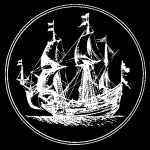
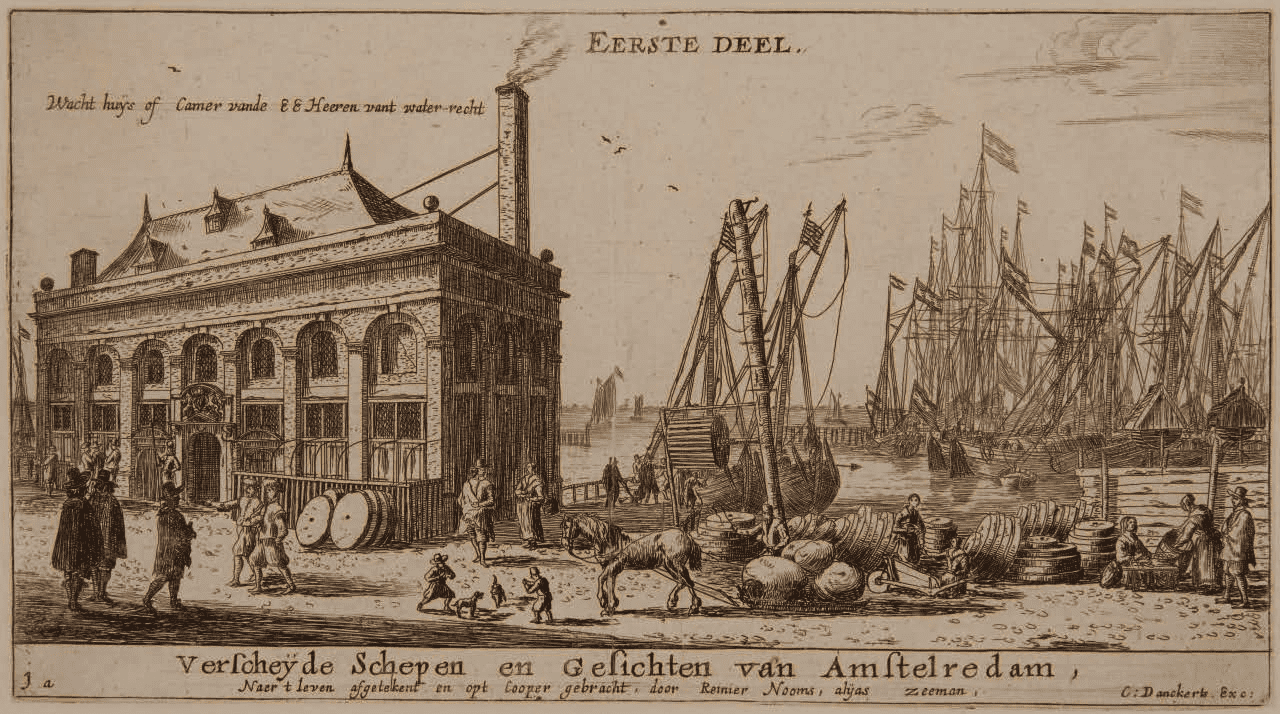
Our art dealership, specialised in maritime paintings, drawings and prints dated before 1900, has been in existence for 35 years. In that time we have regularly published beautifully illustrated catalogues and brochures with the emphasis on the Old Masters. No everyone knew, however, that we have also assembled a unique collection of prints and drawings, mainly from the 17th and 18th centuries. I started collecting while I was still at school and it was only years later that I started our art gallery. Our jubilee, coinciding with that of the year of birth of our most famous maritime hero, Michiel de Ruyter, was an ideal opportunity for us to pay extra attention to artists from previous centuries not only those known for their paintings but those who have also left behind beautiful engravings, etchings or drawings. We have been fortunate enough to acquire the most important complete series to appear in the Northern Netherlands in the 17th and 18th centuries. One of the highlights of our collection is the most famous and most gifted 17th-century etcher of ship’s prints, Reinier Nooms, alias Zeeman. His series of three suites entitled Verscheÿde Schepen en Gesichten van Amstelredam (Various ships and views of Amsterdam), consisting of 36 pages, can be regarded as a high point in the art of print making in the 17th century. We may state with justifiable pride that no comparable collection has been put together and put on offer in the last few decades either in the Dutch or the international art world!
Ludolf Backhuysen was also a skilful etcher. Twenty etchings are known, sixteen of which were certainly done by Backhuysen. Recently we have been able to add a large 4-page etching by Backhuysen to the collection of his works. We have acquired the wonderful series “D’Y stroom, en Zeegezichten” (The River Y and Seascapes).
We can also claim Jan Porcellis, Siewert van der Meulen and Gerrit Groenewegen (18th century) and a rare series of etchings by Johan Barthold Jongkind.
All these prints give a faithful picture of the types of vessel sailing in the 17th and 18th centuries and, as well as being extremely pleasant to look at, they constitute a source of information for historians and maritime archaeologists.
A great deal of work has gone into the present volume. Naturally, first and foremost the collecting; the search for undamaged prints was a time-consuming but exciting task that took us to every corner of the country. But the research also involved many hours of sniffing around in written and printed sources. And, finally, there was the creation and design of this review catalogue and – lest we forget – the writing of the text. We were continually obliged to keep at the back of our minds the fact that the written information had to be accessible to non-museum people. The printing was the final stage, and now you have the result before you!
We wish you a great deal of pleasure in perusing this small book – and if your interest and enthusiasm are as great as ours, this jubilee publication will have achieved its aim.
To conclude. Over the past few decades we have met many people. A number of them became customers; we are grateful for the confidence they have shown in us. Our thanks are also extended to the museums. When we first started out and as yet had no library of our own, they showed us the way round their documentation centres. The fact that over the years we have been able to supply important paintings is partly thanks to these initial contacts. I would like to close by mentioning two persons who have been, for me personally, of inestimable value: Ed Bekkers and Hans van Dam. They may be regarded as the best restorers I know – even at international level. In my early days I learned to ‘look at’ paintings in Ed Bekkers’ welcoming studio in The Hague. He pointed out the mistakes I was making as a beginner in the art market: he was my first teacher. Later, in London, I was a frequent visitor to Hans van Dam. I recall with pleasure the many hours I spent in his studio, talking about paintings, signatures and – last but not least – condition. This exhibition, then, is also by way of homage to those who have supported me with their advice and assistance!
Bergen, autumn 2007
Rob Kattenburg
Rob Kattenburg in his library holding(the book) Gerard Brandt,
Het leven en bedrijf, van den Heere, Michel de Ruiter, uitgave 1687
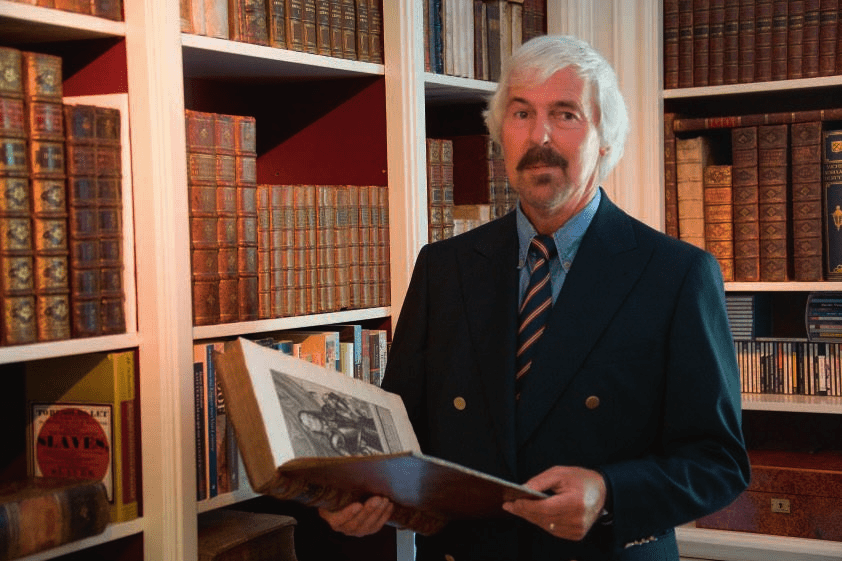
Reinier Nooms is unanimously regarded as the 17th century’s greatest etcher of ships and cityscapes. Cornelis Danckerts published his major series in 3 suites of 12 etchings each shortly after 1652. We have now succeeded in acquiring the complete suite, consisting of 36 etchings! An extremely rare acquisition with which we are more than pleased!
Reinier Nooms, alias Zeeman
Reinier Nooms, alias Zeeman reached the peak of his career in the middle of the seventeenth century and was surely one of the of Amsterdam’s most distinguished and renowned marine painters. He was born in 1623 or 1624, and probably in Amsterdam. On 6 april 1653, he married Maria Jansdr Mozijn or Mouzijn, the elder sister of the engraver Michiel Mozijn with whom Nooms collaborated at least two times.
Nooms stayed in Paris sometime between 1650 and 1652, when he may have become acquainted with the art of etching, possibly training in the workshop of the marine --- Michiel van Plattenberg. Shortly after his return from Paris, Reinier Nooms issued a few prints on his own, but he must have entered into a sort of business agreement with Cornelis Danckerts. As in his paintings, the artistic challenge of capturing the atmospheric effects of depth and light is similarly felt in Zeeman’s etchings.
In 1661 Nooms set out for the Mediterranean with a Dutch fleet under the command of Admiral Michiel de Ruyter. The famous admiral was sent to the Barbary coast to put an end to the pirates who had done considerable harm to the Dutch fleet of merchantmen. During this journey Nooms made numeral sketches.
Zeeman’s last project in the realm of printmaking was the series Large harbour scenes. In 1675 the London print publisher Arthur Tooker stated that he had acquired the plates directly from the artist.
Nooms’ career lasted no longer than ten years, but in that short period he attained a level that can be regarded as the high point of the 17th-century art of etching.
Drawn from real life
Nooms must have been closely acquainted with the vessels of his time for his etchings are placed on the copper artistically, velvet-soft, like drawings, spontaneously and true to life. His work that has come down to us is of inestimable value to maritime historians and restorers of antique model ships. Nooms brings to life almost all the types of ship then known – no fewer than forty, from impressive war man-of-war, Straatvaarders (that sailed through the Straits of Gibraltar) and large Retourschepen, merchantmen destined for the East Indies, down to the smallest vessels plying the inland waterways. Also he often names the vessel and/or its type, such as De Vrÿheÿt een Oorlogs Schip (the Freedom, a Warship), De Hasewint een Spaens vaerder or simply Een Smalschip (a narrow vessel). It cannot be denied that he drew these ships from real life. As well as ships and shipping, a favourite subject of his was the city of his birth, Amsterdam. This port on the river IJ had developed into a metropolis in the 17th century and was regarded as one of the most important centres of trade in Europe. In its harbours there was continual to-ing and fro-ing of merchant vessels and warships, dispatch boats and smaller flat-bottomed vessels used for ferrying goods and passengers along the rivers. At fixed times and from various places in the city the ferries left for Haarlem, Rotterdam, Delft and other major cities. Notable spots in Amsterdam, such as the artificial island known as Bickers Eylandt, the Rokin met de beurs (Rokin with the stock exchange) and important buildings such as the Heerenlogement, the sturdy towers, dating from the Middle Ages, known as the Montelbaanstoren, the Schreierstoren and the Haringpakkerstoren, did not escape his attention and were immortalised in rapid sketches. Reinier Nooms can with some justification be called a reporter and ‘photographer’ avant la lettre, but he was above all one of the Golden Age’s greatest etchers.
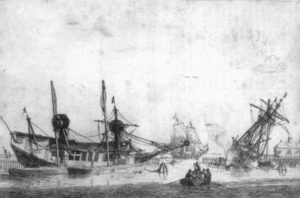
Two vessels careened for caulking the hull, in foreground rowing-boat
Etching: 19,4 x 29,5 cm
Third state of eight
Before the address of Ar.Tooker Exud.Londini (Fourth state of eight)
Private collection Rob Kattenburg
H.122
Complete series consisting of:
Title page, etching by L. Backhuysen
Portrait of Backhuysen, Mezzotint by J. Gole
And 10 pages of etchings by L. Backhuysen
plus a hymn by J. van Broeckhuysen, on a separate plate
Literature:
Hollstein’s, Dutch and Flemish Etchings Engravings and Woodcuts c. 1450-1700
Volume I, Menno Herzberger, Amsterdam Pl.56 to 58 W;B. DUT. 1-10;
De Groot and R. Vorstman, Sailing ships Prints by the Dutch masters from the sixteenth to the nineteenth century, Gary Schwartz, Maarssen Pl 110 to 115;
Gerlinde de Beer, Ludolf Backhuysen (1630-1708)- Sein Leben und Werk, Waanders Uitgevers, Zwolle, Abb 217 p. 169, Abb 218 and 219 p. 170, Abb 220, 221 and 222 p. 171, Abb 223 and 224
p. 172, Abb 225 p. 173, Abb 227 and 228 p. 174
As well as being a wonderful marine painter, Backhuysen was also very skilled in drawing and etching. He produced relatively few works: twenty etchings are known, sixteen of which can certainly be attributed to him.
Recently, we have been able to add to his works a very large early etching, spread over four pages as a test print, to be dated around 1660. The series we have presented – D’Y stroom en Zeegezichten (The River Y and Seascapes) from 1701 – were etched by Backhuysen when he was seventy-one years old. The etchings are of high quality, extremely attractive and drawing-like. Was Backhuysen trying, at an advanced age, to prove that he was still as good an etcher as Reinier Nooms, alias Zeeman?
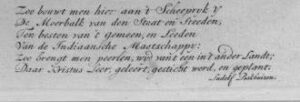
The personification of the city of Amsterdam on a triumphal car on the IJ
This etching (no. 3) is the high point of the series. Here Backhuysen focuses attention on the seafaring trading city of Amsterdam. On the left we see the city’s patroness holding the familiar shield with the three St. Andrew’s crosses. The triumphal car is drawn by sea horses, and the sea god Neptune stands with his trident behind the enthroned maiden. The tableau is situated on the IJ, the river that contributed to the growth of Amsterdam. In the background we see the National Maritime Stores, the colossal building belonging to the East Indies Company (VOC), which currently houses the wonderful Maritime Museum. On the right we see a great warship, the Amsterdam, recognisable by the city’s coat of arms on its squared stern. It is a well-known vessel that was built in the VOC shipyard in 1688 under the leadership of master shipbuilder Hendrik Cardinaal. Its armament consisted of 64 cannons and it had a crew of no fewer than 350 men!
Maritime business was carried out at the time – as it still is – mainly on the IJ. The wide river, bearing colossal freighters and warships decked out with flags and long pennants with, in among the giants, VOC yachts, various flat-bottomed craft (kaag, boeier and small scow), was one of the masters painter’s favourite subjects. Etching no. 6 shows the IJ with, in the distance, Amsterdam, the circular Lutheran church being clearly recognisable and also the new Town Hall on Dam Square. A man-of-war has just raised anchor and is sailing towards the Zuyder Zee. On the left a fluit can be seen, a fast and cheap cargo ship that could be easily managed by a small crew.
Etching no. 5 shows a VOC yacht, the limousine of the 17th century. These small but richly decorated vessels were used by highly-placed VOC officers to travel comfortably to the cities with a VOC office.
Wooden ships require a great deal of maintenance, the section below the waterline requiring regular cleaning, necessitating laying the ship on its side. Print no. 10 shows this procedure. An unremarkable detail in etching no. 8 – but all the more attractive for that – is the small boy pictured flying a kite on the beach.
This complete series of ten etchings gives a unique picture of the period: each etching is different but together they form a unity whereby the aged Backhuysen also demonstrated that he still excelled in his art
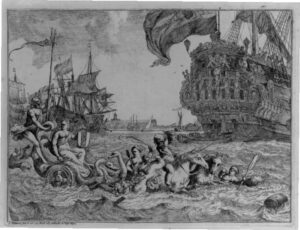
Etching: 20,4 x 25,3 cm
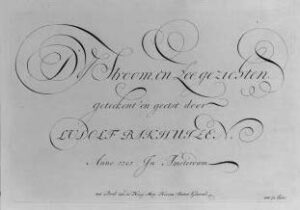
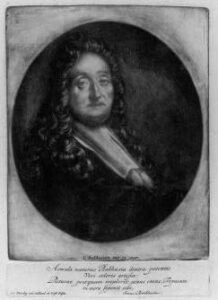
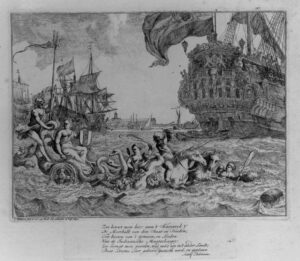
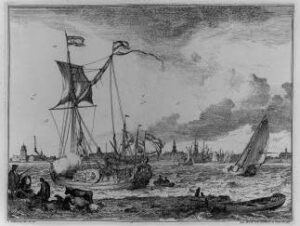
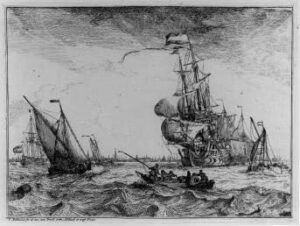
– F. C. Wills, Die Niederlandische Marine Malerei, Leipzig 1911
– Laurens J. Bol, Die Holländische Marinemalerei des 17. Jahrhunderts, Braunschweig 1974
– Rupert Preston, The Seventeenth-Century Marine Painters of the Netherlands, Leigh-on-Sea 1974
– National Maritme Museum, Concise Catalogue of Oil Paintings in the National Maritime Museum, Woodbridge 1988
– George S. Keyes, Mirror of Empire, Dutch Marine Art of the Seventeenth Century, Cambridge 1990
– J. Giltaij, J. Kelch, Lof der Zeevaart, De Hollandse zeeschilders van de 17e eeuw, Museum Booijmans-Van Beuningen, Rotterdam 1996
– E.H.H. Archibald, Dictionary of Sea Painters, Woodbridge, Suffolk, GB 1980,
– Dr. Gerlinde de Beer, Ludolf Backhuysen Sein Leben und Werk (1630-1708), Zwolle 2002
– Henri Nannen, Ludolf Backhuysen, Emden 1985
– B.Broos, R.Vorstman, W.L. van de Watering, Ludolf Backhuysen, schryfmeester-teyckenaerschilder, Amsterdam-Emden 1985
– Marius, Dutch Painters of the 19th Century, Woodbridge 1908
– M.S. Robinson, Van de Velde Drawings. A Catalogue of Drawings in The National Maritime Museum made by the Elder and Younger Willem van de Velde, 2 vols.,Cambridge 1958/1974
– R.E.J. Weber and M.S. Robinson, The Willem van de Velde Drawings in the Boymans-Van Beuningen Museum, Rotterdam, 3 vols., Rotterdam 1979
– S.E. Giepmans, A. Kos, R. van ’t Zelfde, Hollandse stranden in de Gouden Eeuw, Katwijk 2004
– Dordrechts Museum, Tussen zonnegoud en kaarslicht Dordtse meesters 1780-1840, Dordrecht 1986
– J.C. de Jonge, Geschiedenis van het Nederlandsche Zeewezen, 6 vols., Haarlem 1858-1862
– J.C. Mollema, Geschiedenis van Nederland ter zee, 4 vols., Amsterdam 1939-1942
– F. Leeman, H..Pennock, Catalogue Museum of Paintings Mesdag and Drawings, Amsterdam, Zwolle
– Hollstein’s, Dutch & Flemisch Etchings, Engravings and Woodcuts 1450-1700 (1991), Vol. XXXIX, XXXVIII, LVI
– Hollstein’s, Dutch and Flemish Etchings Engravings and Woodcuts ca 1450-1700 volume I, Menno Herzberger, Amsterdam
– Weigel 1843
– Andresen 11; D VI
– Le Bl.
– Van Stolk 1986 W.
– De Groot and R. Vorstman, Sailing ships, Prints by the Dutch masters from the sixteenth to the nineteenth century, Gary Schwartz, Maarssen, 1980
– A. v. Wurzbach, Niederländisches Künstler-Lexikon A-Z, Amsterdam
– Catalogue Rotterdam, Ratsma, Gerrit Groenewegen, 1976 – 77 nr 23
– Michel Melot, Graphic art of the pre-impressionists, Harry N. Abrams, inc., publishers, New York
– Delteil
– Hefting
– V.d. Krogt, Advertenties 179; V.d. Krogt, Globi Neerlandici, V.d. Krogt, Old Globes in the Netherlands, Val 16 & 19 (this pair); cf. Yonge, Cat. Early Globes in the United
States,Globes at Greenwich
– D. Wildeman, De Wereld in het klein, Globes in Nederland
– E. de Groot, The World of a Seventeenth-Century Collector, The Atlas Blaeu-van der Hem
– F.G. Waller, Biographisch Woordenboek van Noord Nederlandse Graveurs, Amsterdam
– Dr.Ir. C. Koeman, Atlantes Neerlandici Vol. IV, Amsterdam
– W.Gaade, Zeilvaart 1520-1914, Den Haag
– N. Israel, Theatrum Orbis Librorum, Utrecht
Colophon
Design and research: Rob Kattenburg
Photography: Pieter de Vries
Production: Drukkerij Die Keure, Brugge
Typesetting: Holger Schoorl
Translation: Meesterwerk Talen TM
This catalogue is published by Rob Kattenburg BV
Rob Kattenburg BV, Eeuwigelaan 6, 1861 CM Bergen. Netherlands
Tel.+31 (0)72-5895051 Fax +31 (0)72-5816031
[email protected], www.robkattenburg.nl
By appointment only
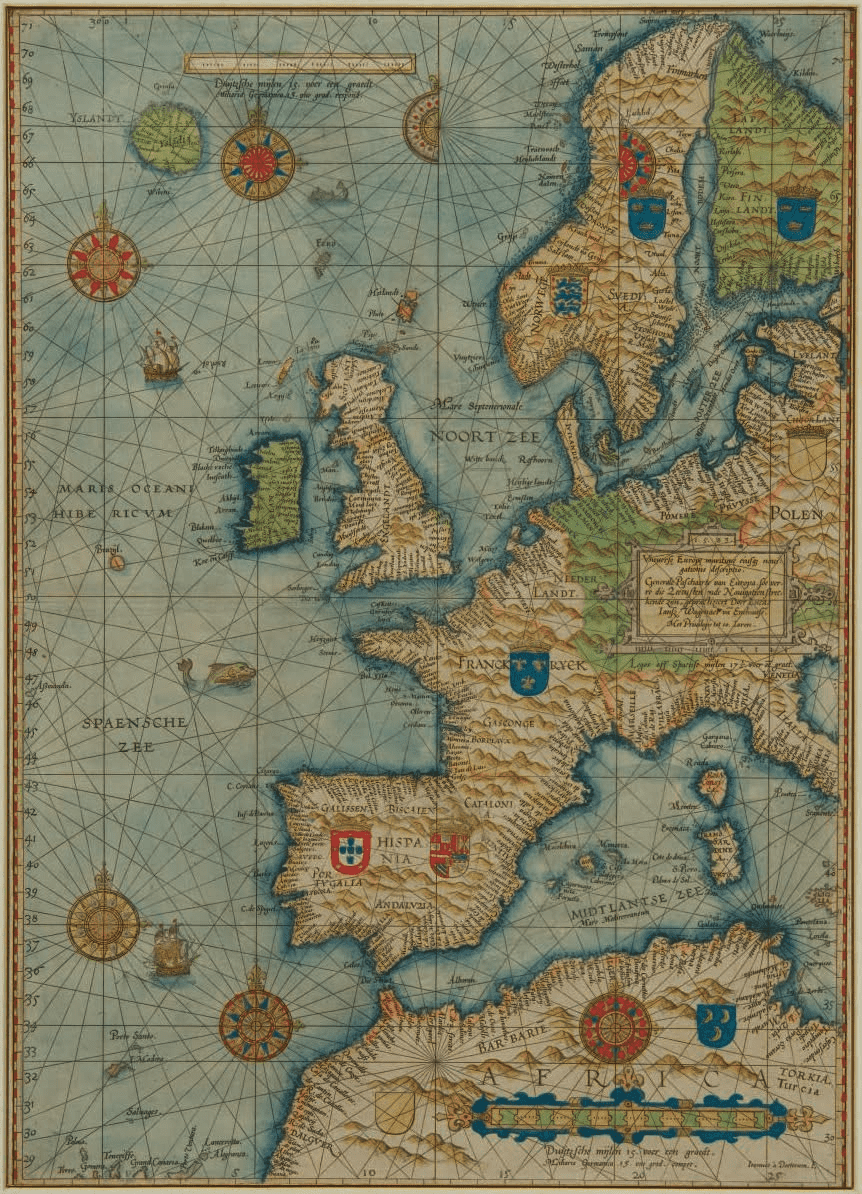
Rob Kattenburg BV, Eeuwigelaan 6, 1861 CM Bergen. Netherlands – Tel.+31 (0)72-5895051 Fax +31 (0)72-5816031
[email protected], www.robkattenburg.nl – By appointment only
Literature:
Dr. Ir. C. Koeman, Atlantes Neerlandici, Vol. IV, Amsterdam, p. 465 to 467 and p. 472 K. 1A
N. Israel, Theatrum Orbis Librorum, pp. 78 to 84, illustration p. 81.
Very fine and very rare map met contemporary colouring, dated 1583.
Lucas Janszoon Waghenaer
Born and bred in Enkhuizen, a town that enjoyed enormous economic growth in his lifetime, Lucas Janszoon Waghenaer became the most important pioneer in the development of better and safer navigation at sea. Little is known about his own career at sea, but in his Spiegel der Zeevaerdt he describes himself as “a simple citizen and helmsman at sea”. Waghenaer’s pilot books and charts brought about revolutionary changes in the field of European maritime cartography. These publications gave Dutch cartography worldwide significance!
The series began with the edition of the Spieghel der Zeevaerdt (1584/5) in folio format, followed by the Tresoor der Zeevaert, a pilot book in smaller format. Until a short time ago, two outline maps of Western Europe by Waghenaer were known, both forming an integral part of his Spieghel. The first is the introductory one in the first part of The Spieghel der Zeevaerdt published in 1584. The map (55.5 x 39.2 cm) was engraved by Joannes van Deutecum and is dated 1583. This beautiful map was probably issued to the trade as early as 1583, separately and without text on the verso. It provides a survey of all the coasts of Western Europe. To the north the image stretches right up to the North Cape and Iceland, to the southwest as far as the Canary Islands. Towards the east the whole of the Gulf of Finland is included as is the Mediterranean as far as Rome, the western point of Sicily and Naples. The map offers a much more faithful image than all earlier examples!
Joannes van Doetechum
(Probably Deventer – 1630 Rotterdam)
As far as his younger years are concerned, we know that he learned the art of copper engraving from his father, also called Joannes van Doetechum. The latter ran a family business specialising in engraving and publishing maps and printing and publishing books. Joannes Junior’s brother, Baptista van Doetechum, also worked with his father and brother in the flourishing enterprise. The strong economic growth and the demand for maps and charts brought many orders into the business. Johannes did not live in Deventer his entire life, since from 1592-1593 he worked in Haarlem, then in Amsterdam in 1596 and finally Rotterdam where he died in 1630. Joannes van Doetechum sometimes gave his name as Johan à Duetechum and also Joannes à Doetecum, which can sometimes lead to confusion.
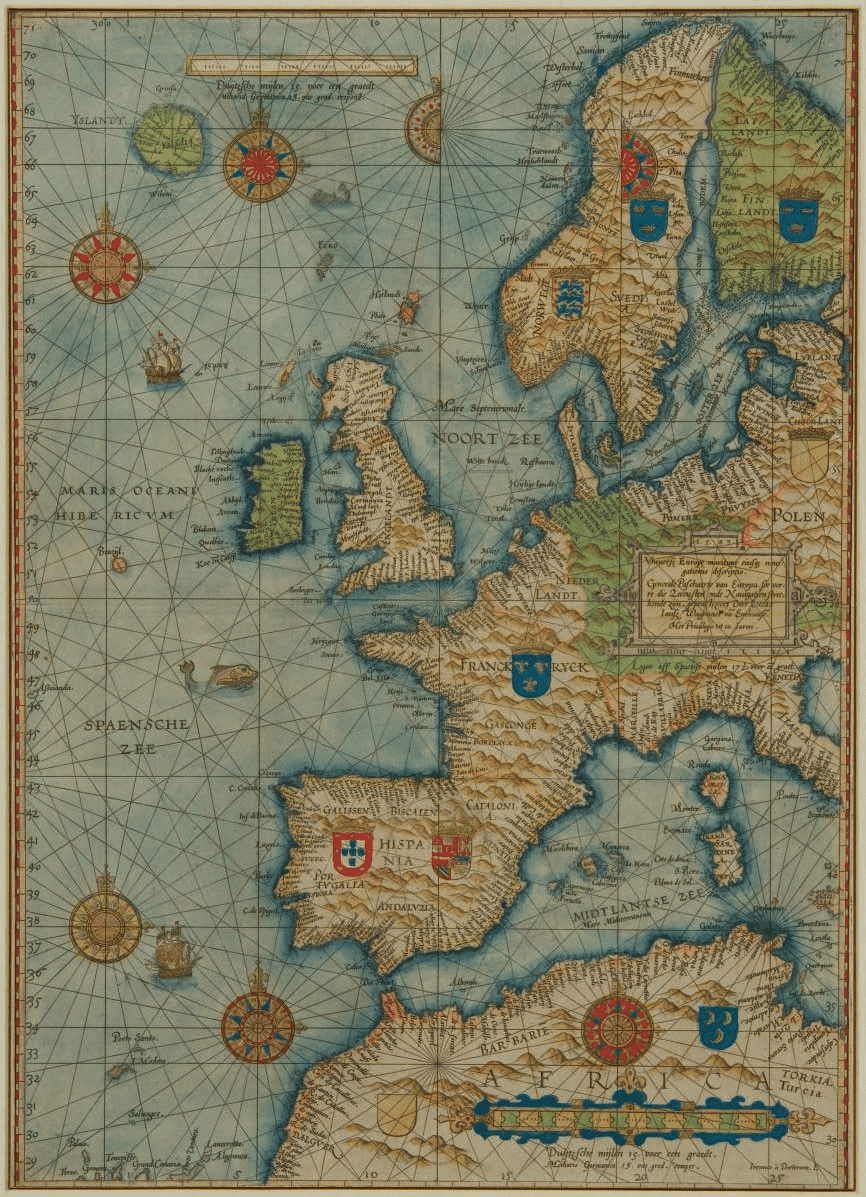
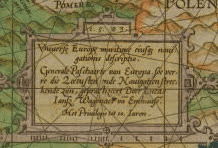
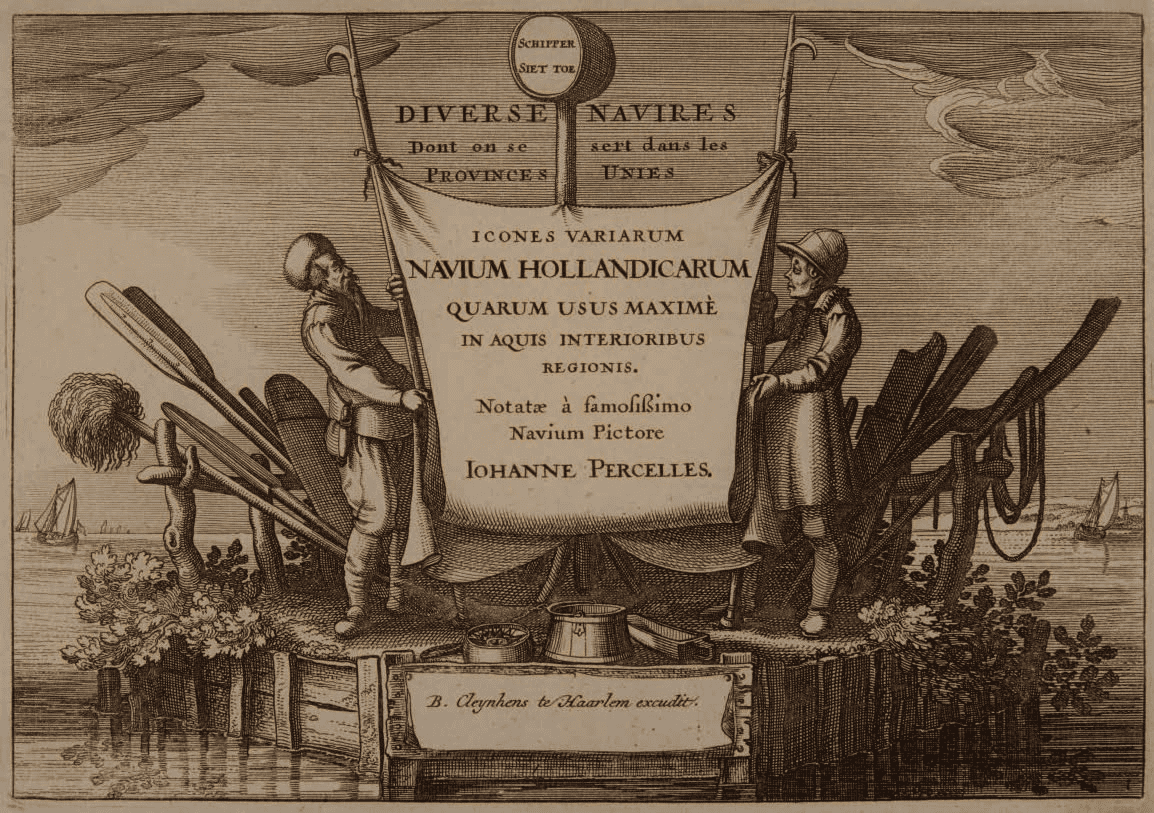
Engraving c. 17,5 x 25 cm
Apart from Visscher’s title page, the series includes eleven numbered plates,
Title page: engraving Claes Janszoon Visscher
Plates 1-11 engraving: Robert de Baudous.
Literature:
Hollstein’s, Dutch & Flemish Etchings, Engravings and Woodcuts 1450-1700 (1991)
p. 151, fourth state of four
The painter Jan Porcellis, of Flemish origin, may be regarded as one of the most important marine artists of the early 17th century. He was the founder of what came to be known as the ‘Tonalist School’. The series shows a number of the commonest flat-bottomed vessels of around 1630. The types of ship illustrated are pictured with great accuracy and form an invaluable source for maritime historians.
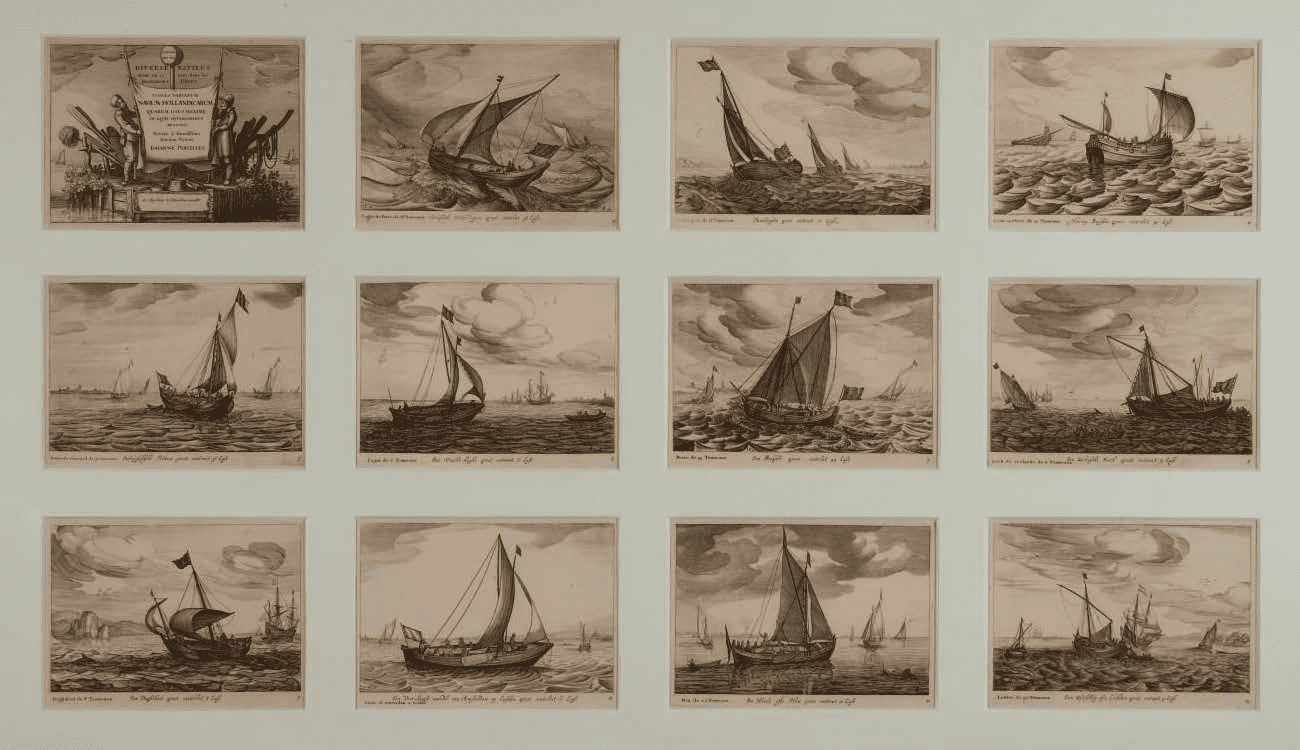
FIRST PART
Verscheÿde Schepen en Gesichten van Amstelredam,
Naer t leven getekent en opt Cooper gebracht, door Reinier Nooms, alÿas Zeeman
C. Danckerts. Exec:
Title page and eleven numbered plates
Etching and drypoint approx. 13.4 x 24.5 cm
Editions:
1 Amsterdam, Cornelis Danckerts
2 Amsterdam, Cornelis Danckerts
3 Amsterdam, Clement de Jonghe
4 Amsterdam, Johannes de Ram
Provenance: Collection Prince Franz I von Liechtenstein, 1853-1939
Literature:
Hollstein’s, Dutch & Flemish Etchings, Engravings and Woodcuts 1450-1700
H. 29- 40 second state of the first suite B. 63-74; Weigel 1843, p. 255; N. 63-74
Andresen 11; D VI, 63-74; Le Bl. 88-99; Van Stolk 1986 W. 63-74

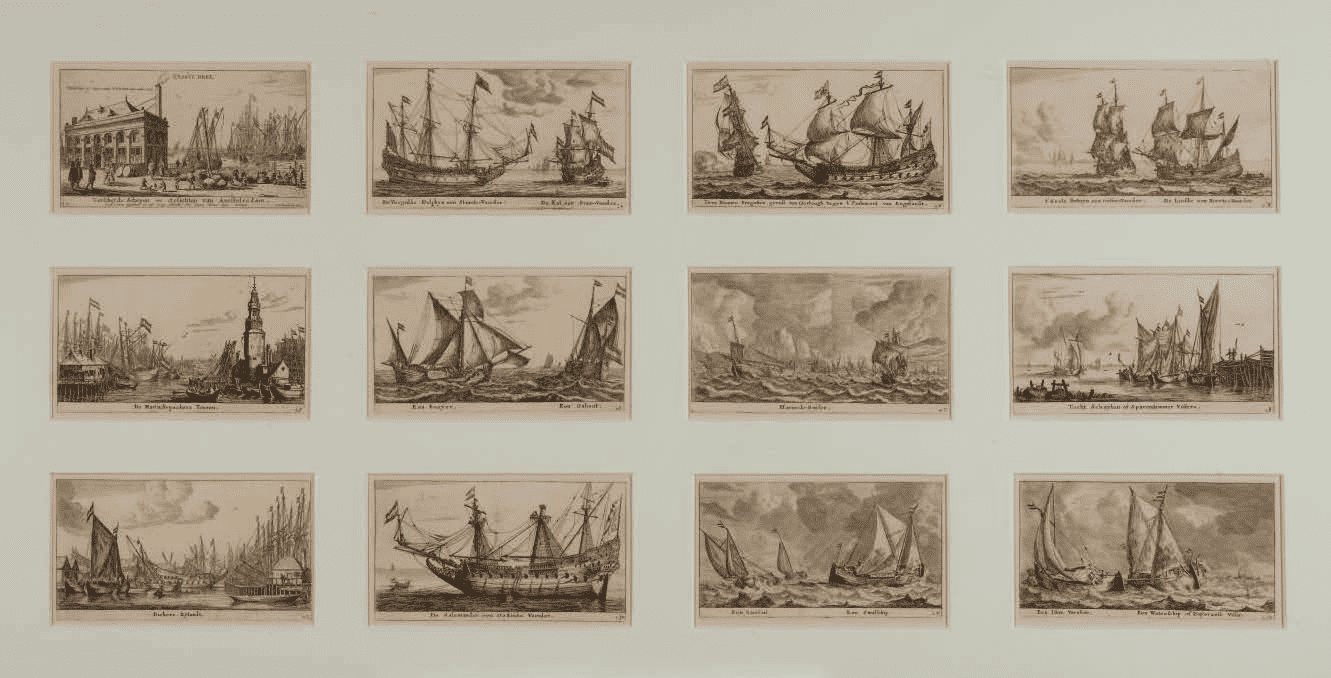
SECOND PART
Verscheÿde Schepen en Gesichten van Amstelredam,
Naer t leven getekent en opt Cooper gebracht, door Reinier Nooms, alÿas Zeeman
C. Danckerts. Exec:
Title page and eleven numbered plates
Etching and drypoint approx. 13.4 x 24.5 cm
Editions:
1 Amsterdam, Cornelis Danckerts
2 Amsterdam, Cornelis Danckerts
3 Amsterdam, Clement de Jonghe
4 Amsterdam, Johannes de Ram
Provenance: Collection Prince Franz I von Liechtenstein, 1853-1939
Literature:
Hollstein’s, Dutch & Flemish Etchings, Engravings and Woodcuts 1450-1700
H. 41- 52 second state of the first suite B. 75-86; Weigel 1843, p. 255; N. 75-86
Andresen 11; D VI, 75-86; Le Bl. 100-111; Van Stolk 1986 W. 75-86
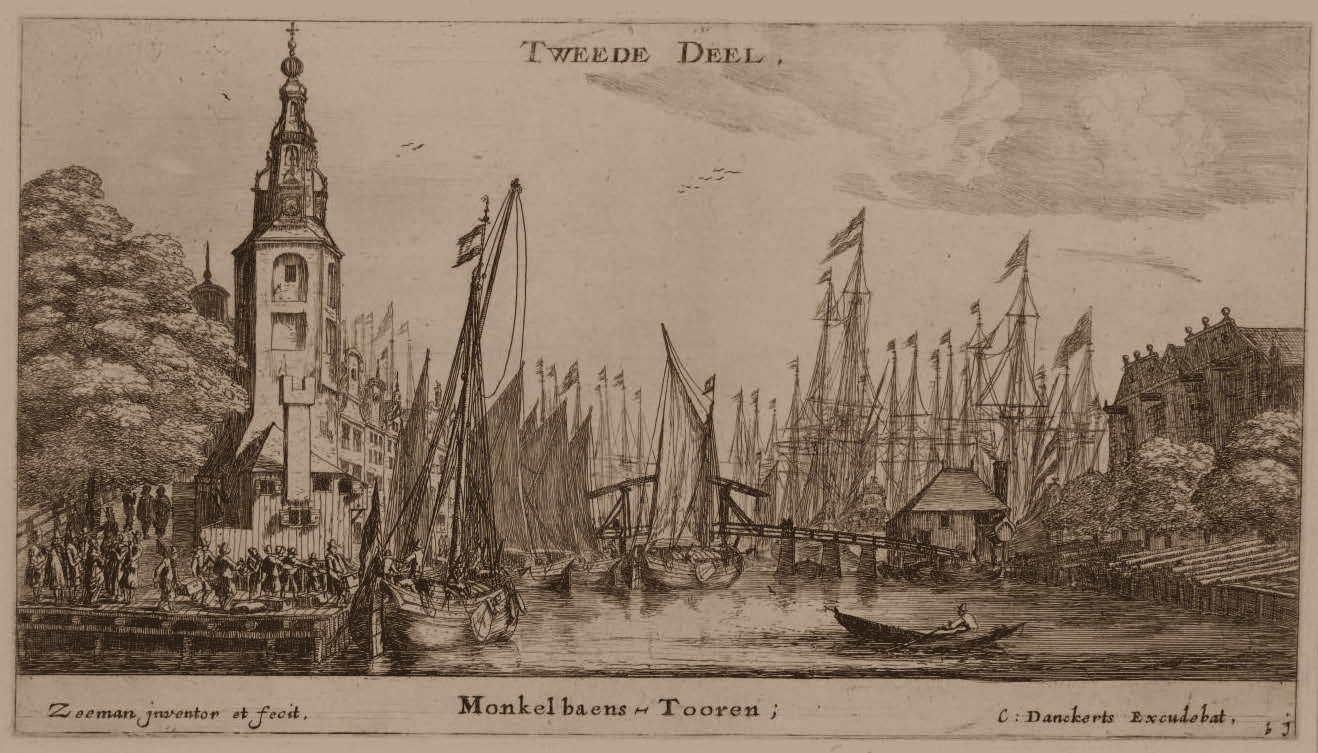
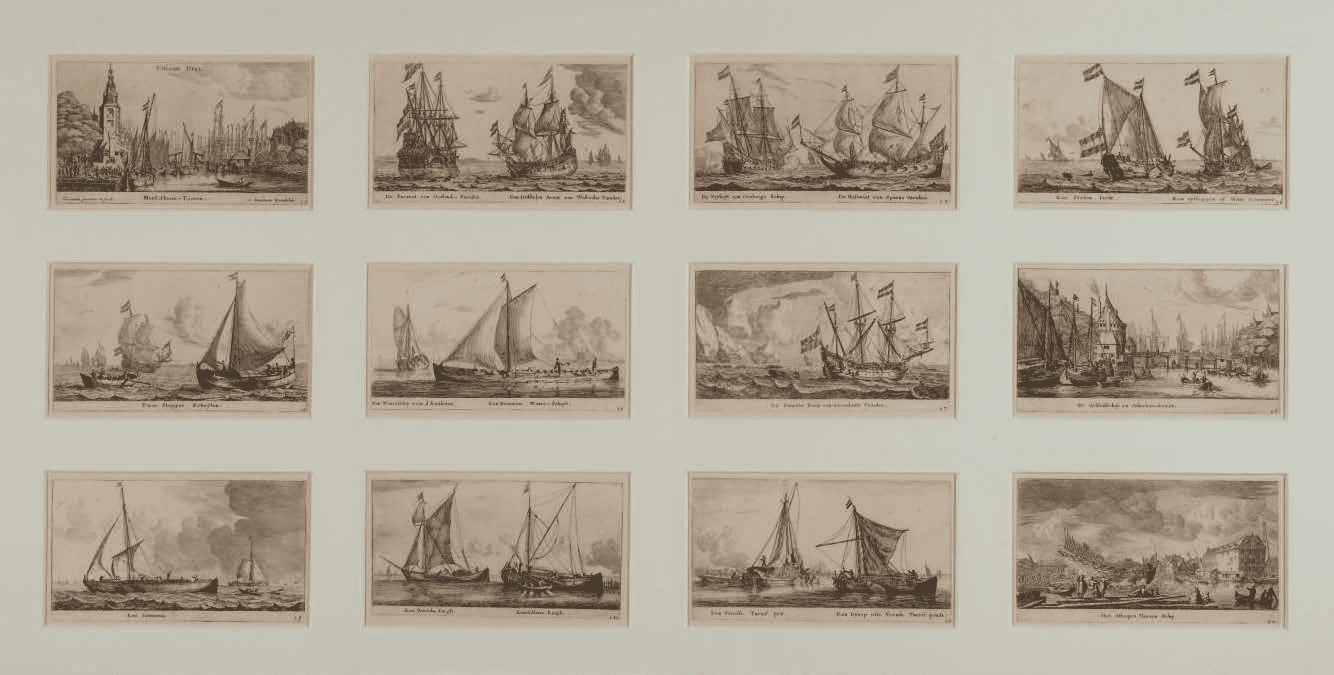
THIRD PART
Verscheÿde Schepen en Gesichten van Amstelredam,
Naer t leven getekent en opt Cooper gebracht, door Reinier Nooms, alÿas Zeeman
C. Danckerts. Exec:
Title page and eleven numbered plates
Etching and drypoint approx. 13.4 x 24.5 cm
Editions:
1 Amsterdam, Cornelis Danckerts
2 Amsterdam, Cornelis Danckerts
3 Amsterdam, Clement de Jonghe
4 Amsterdam, Johannes de Ram
Provenance: Collection Prince Franz I von Liechtenstein, 1853-1939
Literature:
Hollstein’s, Dutch & Flemish Etchings, Engravings and Woodcuts 1450-1700
H. 41- 52 second state of the first suite B. 87-98; Weigel 1843, p. 256; N. 87-98
Andresen 11; D VI, 87-98; Le Bl. 112-123; Van Stolk 1986 W. 87-98
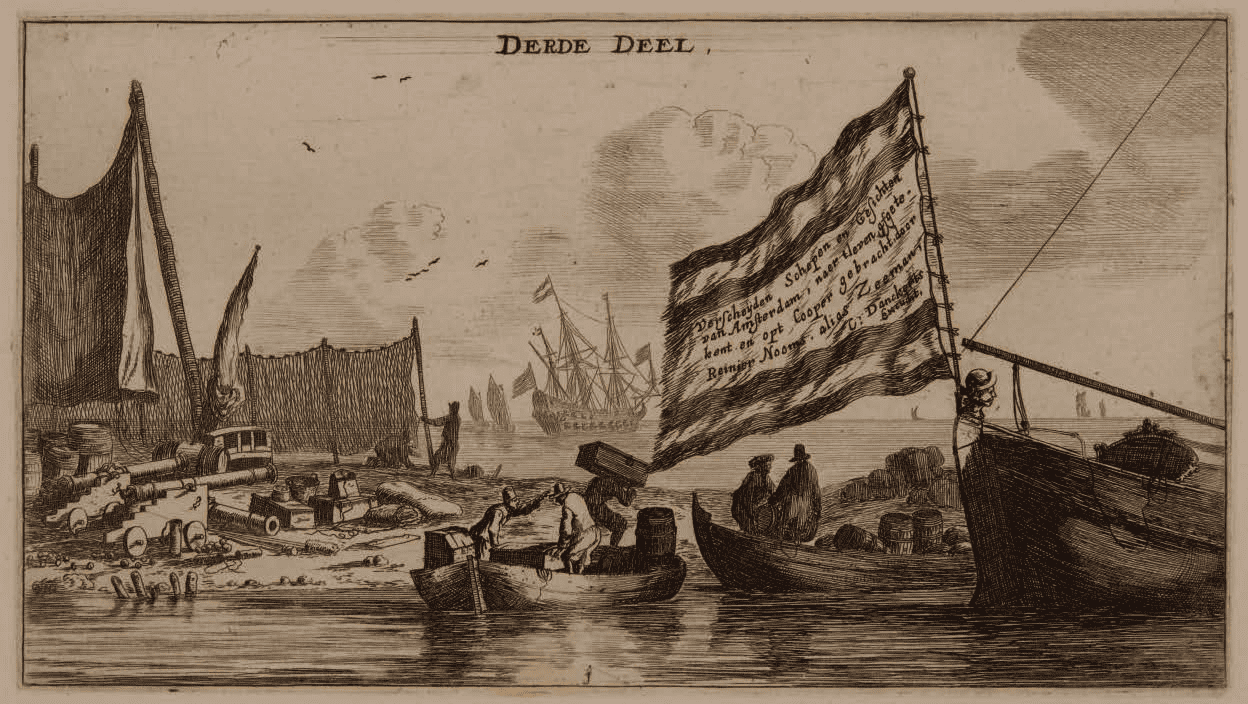
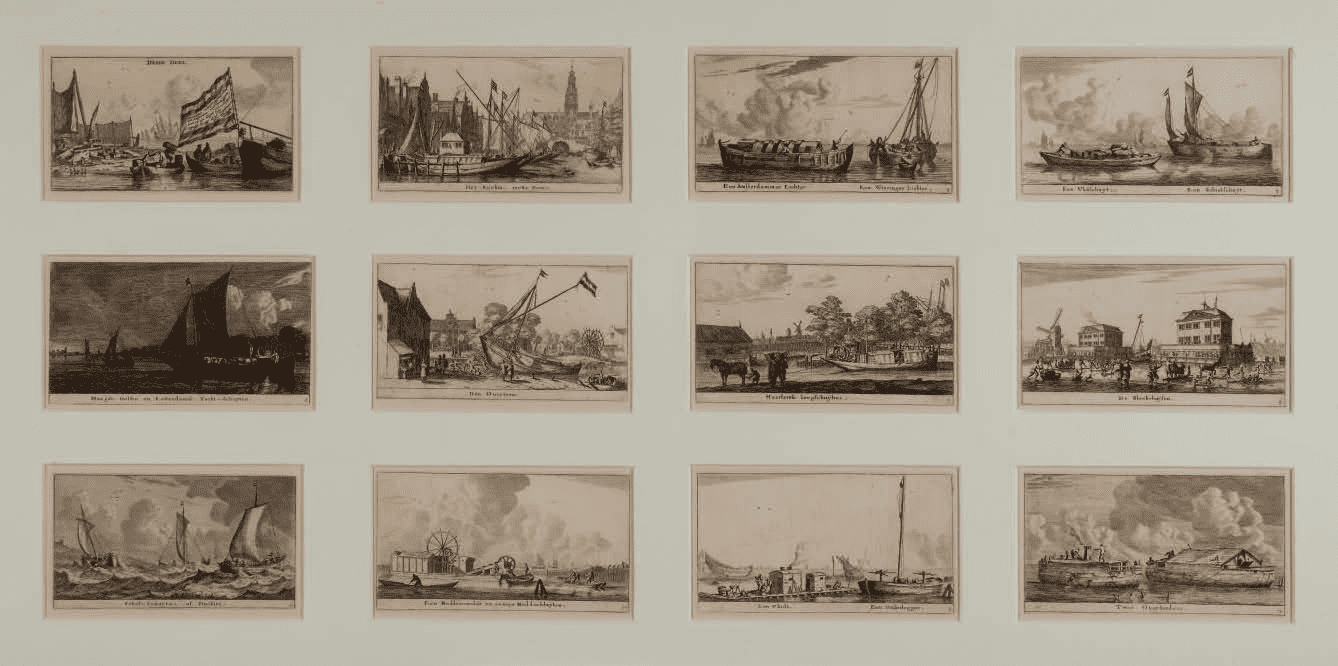
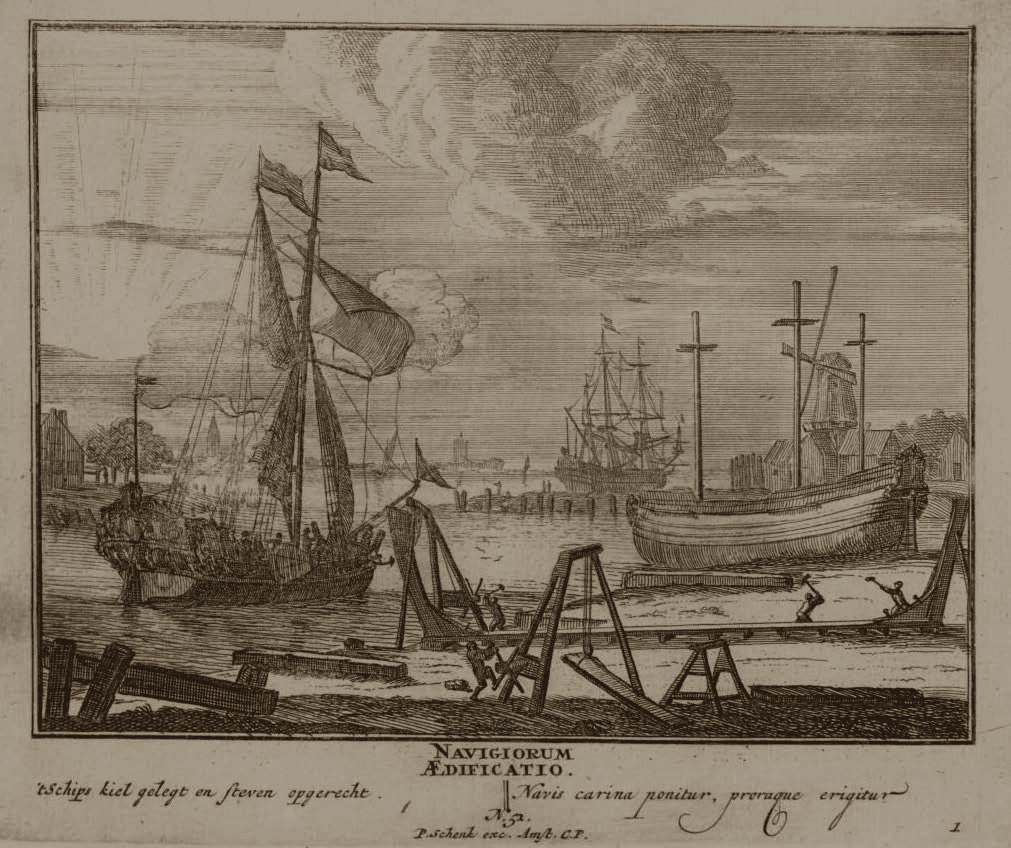
A series of sixteen etchings, all signed by Van der Meulen
Etching: 17.2 x 20.5 cm; with the address of P. Schenk
Literature:
A. v. Wurzbach, p. 155 Muller 1013 A
‘Sailing ships…’ by I. de Groot and
R.Vorstman, illustrated pp. 138 to 153
The adventures of a ship
Pictured by
Siewert van der Meulen
in a successive series of sixteen prints
An early 18th-century comic strip
What moved Siewert van der Meulen to create this series is a mystery but it is certain that the picture story is unique! In the 17th century, shipbuilding was one of the main industries; in the 200 years that the VOC existed, a variety of shipyards laid down and finished more than 1,450 large and small vessels. Thousands of workers from home and abroad earned their daily bread in the industry. The construction of a retourschip (a VOC merchantman) went relatively quickly, the period between the laying of the keel and the launch being an average of one year – and, strange though it may seem to us in the 21st century, all these vessels were built ‘by eye’. Length, breadth and depth were determined beforehand but the shape of the hull was created during construction! The master shipbuilder’s know-how was based on experience, the skills being learned in practice. And nobody came up with the idea of recording all that experience and knowledge! What moved Siewert van der Meulen to create this series is a mystery but it is certain that the picture story is unique! In the 17th century, shipbuilding was one of the main
industries; in the 200 years that the VOC existed, a variety of shipyards laid down and finished more than 1,450 large and small vessels. Thousands of workers from home and abroad earned their daily bread in the industry. The construction of a retourschip (a VOC merchantman) went relatively quickly, the period between the laying of the keel and the launch being an average of one year – and, strange though it may seem to us in the 21st century, all these vessels were built ‘by eye’. Length, breadth and depth were determined beforehand but the shape of the hull was created during construction! The master shipbuilder’s know-how was based on experience, the skills being learned in practice. And nobody came up with the idea of recording all that experience and knowledge!Van der Meulen’s series of etchings are thus extremely informative. By way of clarification the artist placed a short comment under each of the prints. For the builders of replicas such as the ‘Batavia’ and the ‘Amsterdam’ the series formed a welcome complement to what they already knew about shipbuilding. There is a great deal to be seen in the prints. In print no. 3, for instance, The carpenters work on the ship on all sides, we see men working above a fire and bending the heavy oak beams, and, in print no. 6, a crane is being used to put the masts in place. The final process was that of making the ship’s hull watertight using – among other things – ‘harpuys’ (a mixture of oils and resins), a dirty job that could only be done with the ship lying on its side
The real adventures
The ‘life’ of a ship started when first it went to sea. Van der Meulen does not avoid reality: Schepen, door een Zeeslagh geruineerd (Ships ruined by a sea battle), Een Schip door storm overvallen… (A ship attacked by a storm...) and a stranded ship show that life at sea was a dangerous undertaking. Fortunately, however, most ships arrived home safely and, after what were sometimes decades of faithful service, they were brought home and broken up.
In addition to the ships, the prints also show various buildings. Van der Meulen did not pretend to make topographically accurate drawings and yet there are a few references to Amsterdam. In print 6, for instance, the tower behind the ship can be identified as the still-extant Schreierstoren. But that’s all there is: the main focus of interest was, after all, the ships!
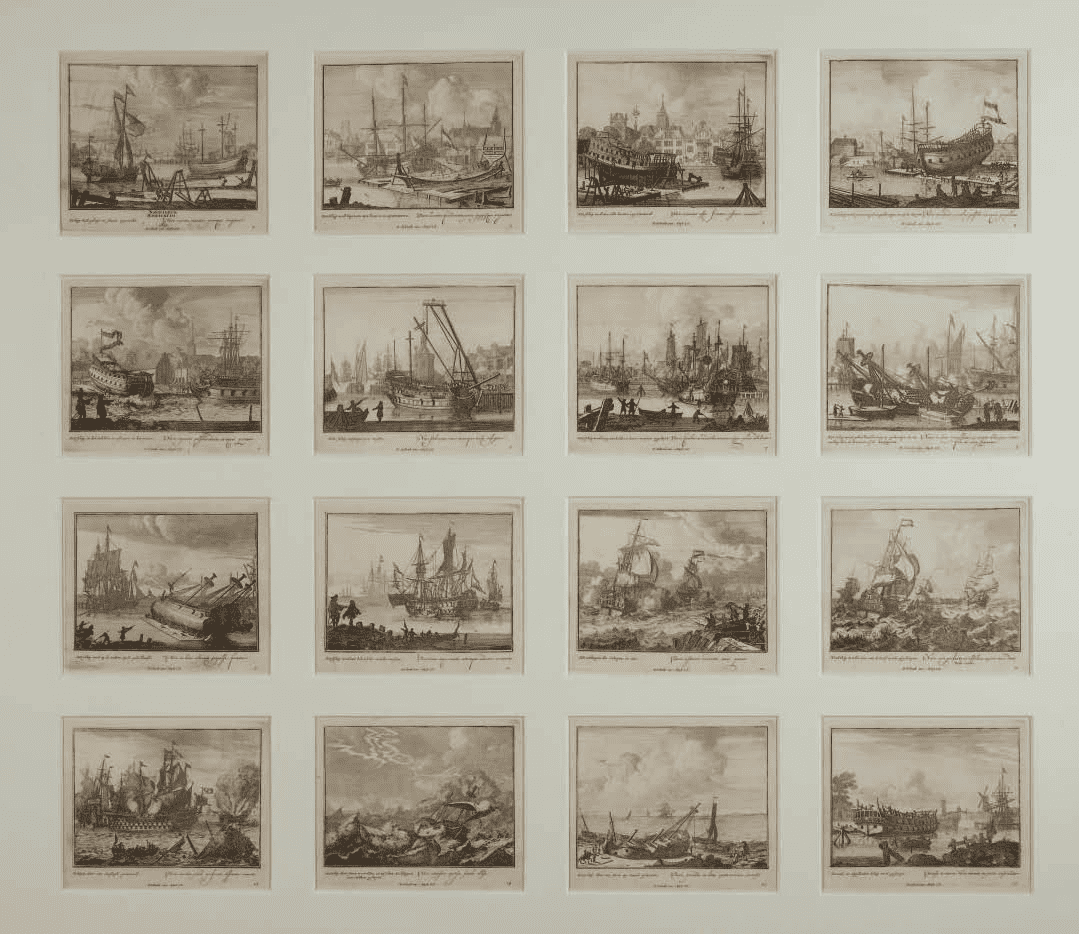
A series of six etchings, all signed by G. Groenewegen
Etching: 15 x 23,1 cm
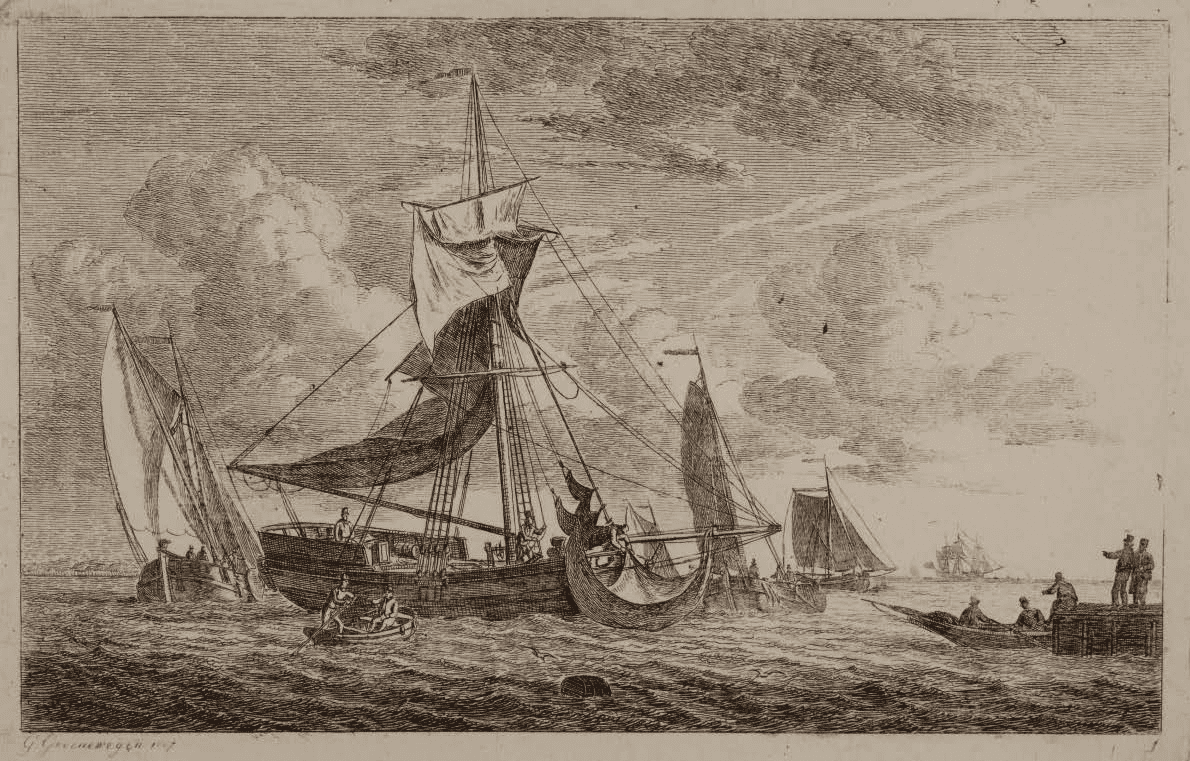
Provenance:
Friedrich August II, King of Saxony
Literature:
Catalogue Rotterdam, Ratsma, Gerrit
Groenewegen 1976 – 77 no. 23
Second state of two, signed and dated 1807,
De Groot and R. Vorstman, Sailing ships Prints by the Dutch masters from the sixteenth to the nineteenth century, Gary Schwartz,
Maarssen, Pl. 204
Wurzbach p. 619
Gerrit Groenewegen was the 18th century’s most important artist involved in drawing ships. He was born in Rotterdam and, like his father, began his career as a ship’s carpenter. However, the young Groenewegen lost part of his right leg in an accident and could no longer pursue his trade. Fortunately, thanks to his great artistic talent, he was able to set himself to drawing and painting ships and views of harbours, in which he gained his greatest renown with his etchings. His accurate representation of the various types of ship is partly due to his practical experience as a ship’s carpenter. The famous marine painter J.C. Schotel used Groenewegen’s etchings as examples in his early studies. Groenewegen has left a large oeuvre of work behind in which he illustrates all the types of vessel of his period. Thanks to his etchings it is possible to describe in detail the navies of the late 18th and early 19th centuries.
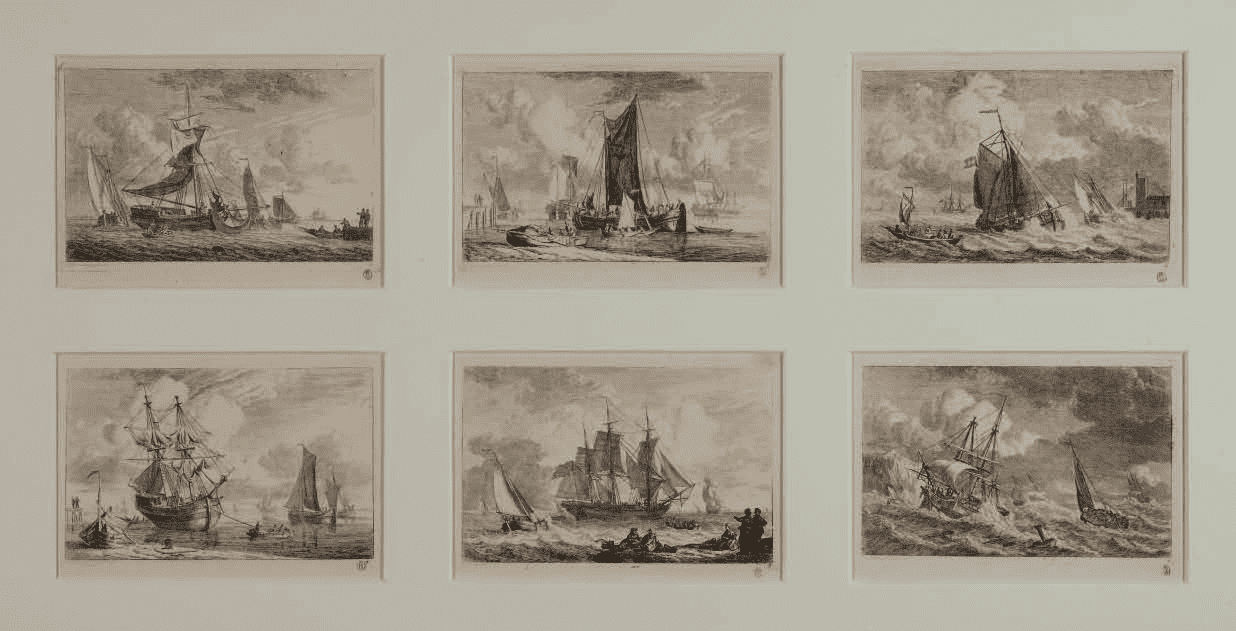
The first etchings by Jongkind. Etching: 17,7 x 21,4 cm

Literature:
Michel Melot, Graphic art of the pre-impressionists, Harry N. Abrams, Inc., publishers, New York
J 1 to J 7
1) Pre-lettering with only signature and date (reversed) reproduced
2) Cadart edition
3) Printing for Sagot
De Groot and R. Vorstman, Sailing ships Prints by the Dutch masters from the sixteenth to the nineteenth century, Gary Schwartz,
Maarssen, Pl. 244, 245
Delteil, Hefting
THE VERY RARE FIRST STATE OF THREE
Jongkind was born in Latdorp in the Dutch province of Overijssel. At an early stage his talent for drawing attracted the attention of no less a personage than the already famous landscape painter Andreas Schelfhout, who became his teacher. The new artistic tendencies in France caused him to decide to move to Paris in 1845. And yet the Holland of his young days, with its broad rivers, characteristic windmills and slowly passing ships continued to excite him for the rest of his life. His works are convincing proof of this.
Much less well known than Jongkind’s paintings are his etchings, of which he made a total of only twenty-one. They are quickly sketched impressions taken from real life and showing the moment and the impression. They demonstrate his skills and mastery, putting him on a comparable level with the great 17th-century masters such as Rembrandt and Jan van Goyen.
This set of six etchings plus title page were printed in 1862 by Delâtre in Paris and published by Cadart. Jongkind probably opted for this publisher because the Societé des Aquaforistes, established shortly before, had had Cadart publish works of members of that club of artists. The Societé had the stated aim of encouraging the art of etching in France. Well-known artists such as Daubigny and Bracquemond were members of the Societé and Jongkind too had joined this group of like-minded people.
On 23rd March 1862, shortly after the album appeared, the famous art critic Philippe Burty wrote an article full of praise for the etchings in the Gazette des Beaux-Arts of 2nd March 1862! It would appear that this brought Jongkind no financial benefit, since on 28th April of the same year he wrote in querulous tones to Poulet Malassis that he had not even covered his expenses!
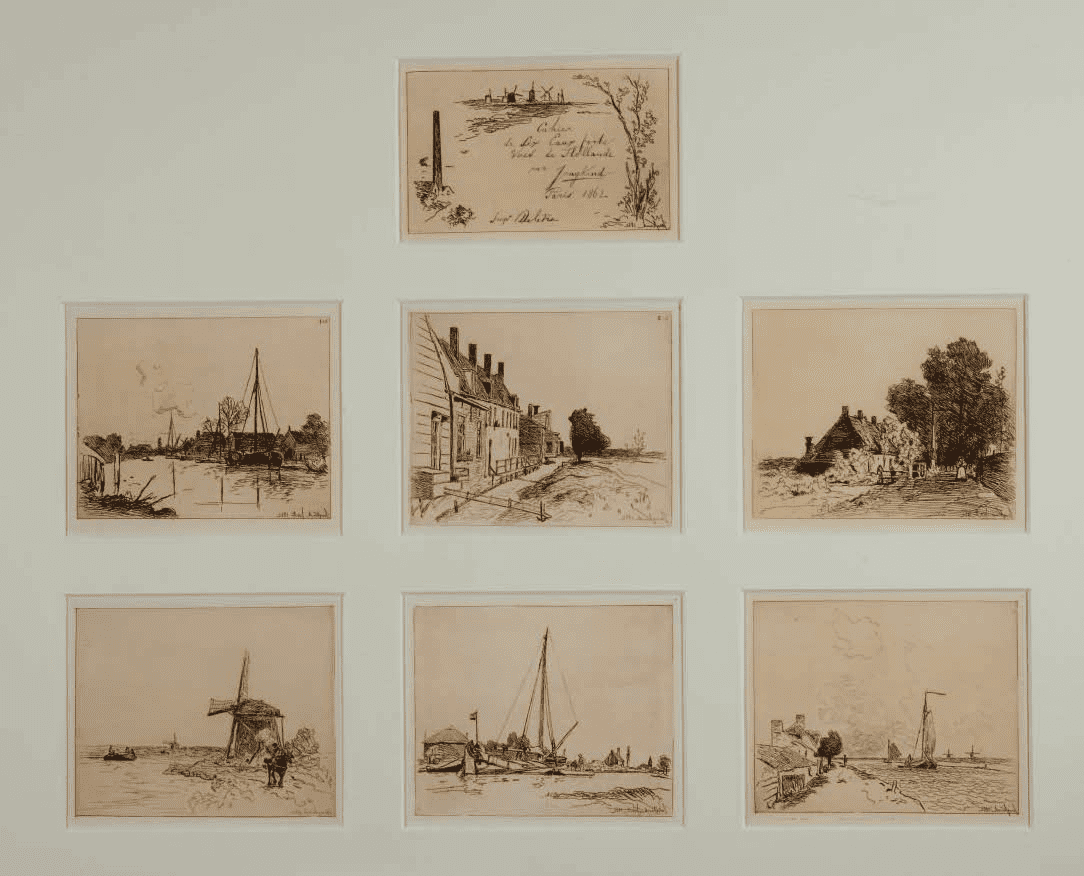
© 2022 Rob Kattenburg
Website Mediya.nl